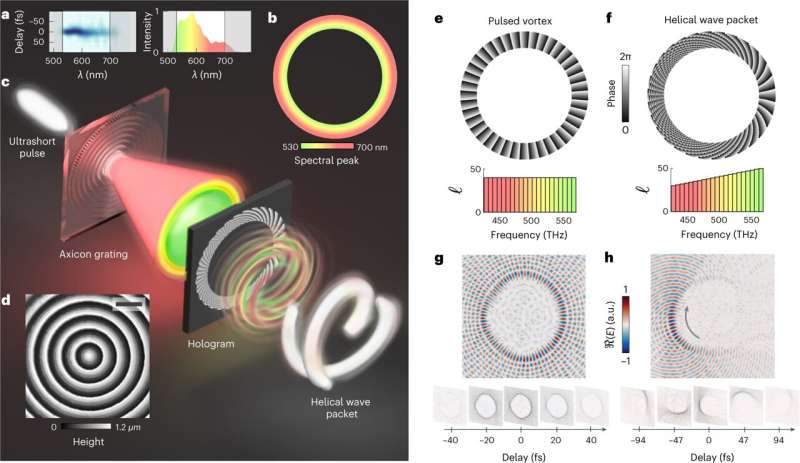This article has been reviewed according to Science X's editorial process and policies. Editors have highlighted the following attributes while ensuring the content's credibility:
fact-checked
peer-reviewed publication
proofread
Ultrashort light pulses shaped like a spring toy bring a new twist to photonics

We've all played at least once with a spring toy, but did you know that light can be shaped like a spring too?
An international team of researchers, led by Marco Piccardo, a former researcher at the Italian Institute of Technology (IIT) and now a Professor in the Physics Department of Técnico Lisboa and Principal Investigator at the Engineering Institute for Microsystems and Nanotechnologies (INESC MN), has harnessed ultrafast optics and structured light to synthesize in the laboratory a new family of spatiotemporal light beams, known as light springs.
The research was done in collaboration between IIT, Politecnico di Milano and Técnico Lisboa. The discovery has a disruptive potential for applications in photonics with complex light, such as time-resolved microscopy (useful, for example, to produce movies depicting the motion of molecules and viruses), laser-plasma acceleration and free-space (e.g., in the atmosphere) optical communications.
The research is published in Nature Photonics.
In ultrafast optics, it is possible to shorten or elongate the duration of extremely short optical pulses—down to a few femtoseconds, or thousandths of billionths of a second—or even produce complex pulses, by means of a technique known as pulse shaping. A central idea to this principle is that short laser pulses are composed of a large range of colors.
Scientists separate a pulse into its constituent colors, which are then separately manipulated and recombined, resulting in a new shape of the laser pulse. While pulse shaping allows to manipulate the time profile of a pulse, there is another set of techniques—known as wavefront shaping—allowing to give light a spatial structure. Designers of light have learnt how to combine these two methods to simultaneously shape light in space and time, bridging ultrafast optics and structured light for entirely new spatiotemporal applications.
A paradigm shift in spatiotemporal light shaping
Reporting now in Nature Photonics, Piccardo and his collaborators have introduced a paradigm shift in spatiotemporal light shaping. Unlike conventional shapers that separate different colors along a colorful strip, now the researchers used a special type of diffraction grating with circular symmetry, to create a round rainbow of colors.
This is an experiment that everyone can try at home: by shining a flashlight on an old CD-ROM and taking a picture with the phone camera, a round rainbow will be captured. Now, replace the flashlight with an ultrashort laser pulse and the CD-ROM with a microstructured diffractive device fabricated in the nanofabrication cleanroom and you are halfway through the experiment. The second part of the experiment consists in using advanced holograms to structure the many colors of light into different optical vortices shaped like a corkscrew.
"This results in a novel family of spatiotemporal light beams, which evolve on an ultrashort femtosecond timescale with a twisted and widely tailorable light structure," said Marco Piccardo. "It opens unprecedented design capabilities in photonics, with many spectral and structural components to address."
The broadband nature of these new light beams poses new challenges for their characterization, which the team has overcome by developing a powerful reconstruction technique, called hyperspectral holography, providing the complete tomography of the complex space-time structures.
"Our technique, which combines holography with Fourier transform spectroscopy, enables full characterization of the spatiotemporal profile of complex beams, enabling radically novel applications in the study of light-matter interactions," said Giulio Cerullo, a Professor in Politecnico di Milano and co-author of the study.
The team showcased the unprecedented control enabled by their space-time shaper by tailoring many properties of the light springs. A beautiful demonstration shows two of such springs dancing together in space and time.
"We have found extremely interesting physics using these beams, which could lead us to a whole new generation of compact accelerators and light sources in plasma. This technique is very exciting because it promises to bring these theoretical concepts to the laboratory and to trigger major advance in laser-plasma physics," said Jorge Vieira, a Professor in Técnico Lisboa and co-author of the study.
Now that it is finally possible to synthesize these light springs with complete freedom in the laboratory, the next natural step will be to bring them in laser-plasma experiments.
"This is a very challenging goal but the nanophotonic fabrication capabilities of INESC MN in Lisbon and the excellent plasma research groups of Técnico represent an ideal ecosystem to pursue this ambitious research," said Piccardo. "Combining these advanced space-time beams with intense nonlinear laser-matter interactions could have important fundamental and technological implications. "
More information: Marco Piccardo et al, Broadband control of topological–spectral correlations in space–time beams, Nature Photonics (2023). DOI: 10.1038/s41566-023-01223-y
Journal information: Nature Photonics
Provided by Técnico Lisboa



















